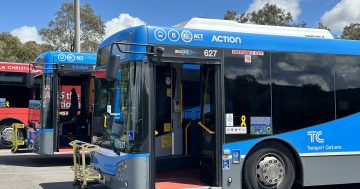
It’s not just about the cranes. Photo: Michelle Kroll.
The now apocryphal story about premiers counting the cranes on the skyline to gauge the health of the economy comes to mind as Chief Minister Andrew Barr oversees a Canberra that is going to be transformed over the next decade.
Right across the ACT, but particularly in the city and town centres, a growing pipeline of construction projects will keep the already well-oiled Canberra economy humming.
Last week the Commonwealth’s $132 million handout for light rail Stage 2A in the city and the development application for the new Woden Interchange highlighted projects that will eventually change the face of those districts.
Anybody who has endured the ramshackle and unfriendly 50-year-old Woden Interchange will not mourn its passing, and Civic West will flourish along the rail line once it is built.
Along the Northbourne corridor, a phalanx of residential towers will rise, while skylines are being remade in Gungahlin, Belconnen, Woden and Tuggeranong.
When light rail finally crosses the lake, the route through the parliamentary zone and down Adelaide Avenue to Woden will alter a landscape that has been so familiar to so many for a long time.
Along Lake Burley Griffin, the West Basin project and the proposed UNSW Canberra campus will continue to fill in the spaces, while a redeveloped Canberra Theatre precinct and the Kingston Arts Precinct will offer a new cultural dimension to our lives, if done well.
Then there are the new suburbs being carved out of the bush in Molonglo, Gungahlin and West Belconnen.
Many argue that Canberra is not set in aspic, but these projects will be a dislocation for many, bringing challenges for government and inevitable disruption to our lives. There is also the risk that the place we love could be trashed.
They will happen in the midst of a nationwide infrastructure boom designed to takes us out of the pandemic-induced economic slowdown that will inevitably turn into a fight for resources and skills in an intensely competitive environment.
Managing this will not be easy, and the public should brace itself for possible blow-outs in costs and timelines for reasons beyond government control.
After a year of COVID-19, in which the Canberra economy suffered at the hands of social restrictions, Mr Barr will say these are good problems to have.

Light rail Stage 2A will be a game-changer for Civic West, but businesses will face disruption. Image: ACT Government.
It will mean a jobs bonanza, and hopefully local business will prosper, if they are not shut out by big out-of-town operators, although they will be necessary if all project needs are to be met.
But the influx of workers will put even more pressure on the city’s accommodation in this construction phase and again expose the inadequacy of a rental market that is the most expensive in the land.
Hopefully, some of the boom will be devoted to more affordable housing and alternatives to apartments, such as terraces.
The volume of work will also give planning officials headaches and may require another beefing up of the bureaucracy to process and deal with applications effectively.
Mr Barr has promised that development applications will still be assessed on their merits and have to meet planning rules and environmental conditions, but in a state of economic recovery and imperatives, pressures may build.
Volunteer community councils and residents groups trying to keep both government and developers honest may be overwhelmed.
For those businesses in the line of fire, such as those in City West through which the next section of light rail will run, it is going to be a rough ride.
The government says it has learnt the lessons of Stage 1 – where businesses in Gungahlin and along the route were hammered by noise, dust and loss of access and customers – and is working with them to manage the disruption.
Managing the sheer level of disruption in many parts of Canberra – from light rail to high-rise towers close to major shopping centres to road duplications – is going to be crucial.
Compared with Sydney, Canberra traffic is a dream, but it is all relative. At the moment, a bingle on the Tuggeranong Parkway or Commonwealth Avenue Bridge is enough to cause gridlock, so be prepared for some almighty hold-ups when work on light rail Stage 2B gets going, or if you’re trying to get into the car park at Westfield Woden.
It is an exciting time for Canberra. The new transport infrastructure will make a huge difference to the city and many underutilised and tired spaces will be rejuvenated.
The trick will be to manage the pace of change, maintain the standards befitting the national capital and for government and developers to remember that it isn’t just about cranes but that people need to be at the heart of outcomes that serve the city.
It’s also going to require patience.
Original Article published by Ian Bushnell on The RiotACT.













